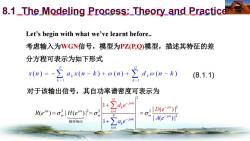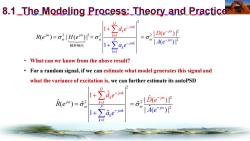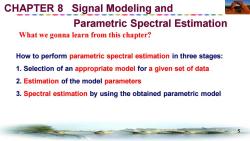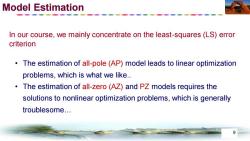电子科技大学:《高级数字信号处理》研究生课程(PPT课件)Chapter 8 Parametric Spectrum Estimation

CHAPTER 8 Signal Modeling and Parametric Spectral Estimation 8.1 The Modeling Process:Theory and Practice 8.2 Estimation of All-Pole Models 8.3 Estimation Of Pole-Zero Models 8.4 Applications 8.5 Harmonic Models and Frequency Estimation Techniques 8.6 Summary
2 8.1 The Modeling Process: Theory and Practice 8.2 Estimation of All-Pole Models 8.3 Estimation Of Pole-Zero Models 8.4 Applications 8.5 Harmonic Models and Frequency Estimation Techniques 8.6 Summary CHAPTER 8 Signal Modeling and Parametric Spectral Estimation

8.1 The Modeling Process:Theory_and Practice Let's begin with what we've learnt before. 考虑输入为WGN信号,模型为PZP,Q)模型,描述其特征的差 分方程可表示为如下形式 x(n)-d:x(n-k)+o(n)d,o(n-k) (8.1.1) 对于该输出信号,其自功率谱密度可表示为 2 l+∑dea R(e)=o2|H(e0)P=o2 k=1 2D(e) A(e-jo)2 频率响应 ae-jok
8.1 The Modeling Process: Theory and Practice Let’s begin with what we’ve learnt before. 考虑输入为WGN信号,模型为PZ(P,Q)模型,描述其特征的差 分方程可表示为如下形式 对于该输出信号,其自功率谱密度可表示为 2 2 2 2 2 2 2 1 1 ( ) | ( ) | | ( ( )| 1 | | 1 ) Q j k k j P j j j k k j k k R H A e a d e e D e e e − − = − = − = = = + + 频率响应

8.1_The Modeling Process:Theory_and Practice +∑dea R(e)=H(ef)2 k= 2D(e-i) = A(e-)P 频率响应 1+∑aea k=1 What can we know from the above result? For a random signal,if we can estimate what model generates this signal and what the variance of excitation is,we can further estimate its autoPSD 0 l+∑de R(e)=6 k= =G2ID(e)p l+∑aem Ae)P k=
8.1 The Modeling Process: Theory and Practice 2 2 2 2 2 2 2 1 1 ( ) | ( ) | | ( ( )| 1 | | 1 ) Q j k k j P j j j k k j k k R H A e a d e e D e e e − − = − = − = = = + + 频率响应 • What can we know from the above result? • For a random signal, if we can estimate what model generates this signal and what the variance of excitation is, we can further estimate its autoPSD 2 2 2 1 1 2 2 | | ˆ 1 ˆ 1 ˆ ˆ ( ) ˆ ( ) | | ˆ ˆ ( ) Q j k k P k j k j j j k k d e D A e a e R e e − − = − − = = + = +

CHAPTER 8 Signal Modeling and Parametric Spectral Estimation What we gonna learn from this chapter? How to perform parametric spectral estimation in three stages: 1.Selection of an appropriate model for a given set of data 2.Estimation of the model parameters 3.Spectral estimation by using the obtained parametric model
5 How to perform parametric spectral estimation in three stages: 1. Selection of an appropriate model for a given set of data 2. Estimation of the model parameters 3. Spectral estimation by using the obtained parametric model CHAPTER 8 Signal Modeling and Parametric Spectral Estimation What we gonna learn from this chapter?

Model Selection Choose model Stage 1 structure and Model selection order Stage 2 Estimate model Model estimation parameters Stage 3 Check the Model validation candidate model for performance Is model No satisfactory? Use the FIGURE 8.1 Steps in the signal model building process. model for your application 6
6 Model Selection FIGURE 8.1 Steps in the signal model building process

Model Selection Now,we gonna briefly describe the three stages The model selection determines: 1 The complexity of the algorithm that estimates the model parameters. 2 The shape of the criterion function(quadratic or nonquadratic)
7 The model selection determines: ① The complexity of the algorithm that estimates the model parameters. ② The shape of the criterion function (quadratic or nonquadratic). Model Selection Now, we gonna briefly describe the three stages

Model Estimation Model estimation is also known as model fitting Particularly,we use the available data to estimate the parameters of the selected model,by using the optimization of some criteria(e.g.maximum likelihood,spectral matching)
• Model estimation is also known as model fitting • Particularly, we use the available data to estimate the parameters of the selected model, by using the optimization of some criteria (e.g. maximum likelihood, spectral matching). Model Estimation

Model Estimation In our course,we mainly concentrate on the least-squares(LS)error criterion The estimation of all-pole(AP)model leads to linear optimization problems,which is what we like. The estimation of all-zero(AZ)and PZ models requires the solutions to nonlinear optimization problems,which is generally troublesome. 9
9 In our course, we mainly concentrate on the least-squares (LS) error criterion • The estimation of all-pole (AP) model leads to linear optimization problems, which is what we like. • The estimation of all-zero (AZ) and PZ models requires the solutions to nonlinear optimization problems, which is generally troublesome. Model Estimation

Model Validation The goal of the model validation process is to find out whether the model O Agrees sufficiently with the observed data ●Describes the“true”signal generation system But how to validate the model? Key idea:Check whether the residual process,which is generated by the inverse of the fitted model,is a realization of white noise. 10
10 The goal of the model validation process is to find out whether the model ● Agrees sufficiently with the observed data ● Describes the “true” signal generation system But how to validate the model? Key idea: Check whether the residual process, which is generated by the inverse of the fitted model, is a realization of white noise. Model Validation

Model Validation The whiteness of the residual signal can be checked by the following statistical techniques Autocorrelation test(自相关检测) Power spectrum density test(功率谱密度检测) Partial autocorrelation test(部分自相关检测)
11 •Autocorrelation test(自相关检测) •Power spectrum density test(功率谱密度检测) •Partial autocorrelation test (部分自相关检测) The whiteness of the residual signal can be checked by the following statistical techniques Model Validation
按次数下载不扣除下载券;
注册用户24小时内重复下载只扣除一次;
顺序:VIP每日次数-->可用次数-->下载券;
- 西安电子科技大学:《电路分析基础》课程教学资源(作业习题)课后习题(无答案).pdf
- 西安电子科技大学:《电路分析基础》课程教学资源(PPT课件)第六章 二端口电路.ppt
- 西安电子科技大学:《电路分析基础》课程教学资源(PPT课件)第五章 电路的频率响应和谐振现象(2/4)5.2 一阶电路和二阶电路的频率响应 5.3 串联谐振电路.pptx
- 西安电子科技大学:《电路分析基础》课程教学资源(PPT课件)第五章 电路的频率响应和谐振现象(3/4)5.4 并联谐振电路.pptx
- 西安电子科技大学:《电路分析基础》课程教学资源(PPT课件)第五章 电路的频率响应和谐振现象(1/4)5.1 网络函数与频率特性 5.2 一阶电路和二阶电路的频率响应.pptx
- 西安电子科技大学:《电路分析基础》课程教学资源(PPT课件)第五章 电路的频率响应和谐振现象(4/4)5.4 并联谐振电路.pptx
- 西安电子科技大学:《电路分析基础》课程教学资源(PPT课件)第四章 正弦稳态分析(8/8)4.7 变压器.pptx
- 西安电子科技大学:《电路分析基础》课程教学资源(PPT课件)第四章 正弦稳态分析(5/8)4.5 正弦稳态电路的功率.pptx
- 西安电子科技大学:《电路分析基础》课程教学资源(PPT课件)第四章 正弦稳态分析(4/8)4.4 阻抗与导纳、正弦稳态电路的计算.pptx
- 西安电子科技大学:《电路分析基础》课程教学资源(PPT课件)第四章 正弦稳态分析(6/8)4.5 正弦稳态电路的功率 4.6 互感耦合电路.pptx
- 西安电子科技大学:《电路分析基础》课程教学资源(PPT课件)第四章 正弦稳态分析(2/8)4.2 相量法的基本概念 4.3 电路定律的相量形式.pptx
- 西安电子科技大学:《电路分析基础》课程教学资源(PPT课件)第四章 正弦稳态分析(3/8)4.3 电路定律的相量形式 4.4 阻抗与导纳、正孩稳态电路的计算.pptx
- 西安电子科技大学:《电路分析基础》课程教学资源(PPT课件)第四章 正弦稳态分析(7/8)4.6 互感耦合电路 4.7 变压器.pptx
- 西安电子科技大学:《电路分析基础》课程教学资源(PPT课件)第四章 正弦稳态分析(1/8)4.1 正弦量 4.2 相量法的基本概念.pptx
- 西安电子科技大学:《电路分析基础》课程教学资源(PPT课件)第三章 动态电路(2/4)3.2 动态电路的方程及其解 3.3 电路的初始值 3.4 一阶动态电路的响应.pptx
- 西安电子科技大学:《电路分析基础》课程教学资源(PPT课件)第三章 动态电路(3/4)3.4 一阶动态电路的响应 3.5 一阶电路的三要素公式.pptx
- 西安电子科技大学:《电路分析基础》课程教学资源(PPT课件)第三章 动态电路(4/4)3.5 一阶电路的三要素公式 3.6 阶跃函数和阶跃响应.pptx
- 西安电子科技大学:《电路分析基础》课程教学资源(PPT课件)第三章 动态电路(1/4)3.1 动态元件.pptx
- 西安电子科技大学:《电路分析基础》课程教学资源(PPT课件)第二章 电阻电路分析(4/5).pptx
- 西安电子科技大学:《电路分析基础》课程教学资源(PPT课件)第二章 电阻电路分析(5/5).pptx
- 电子科技大学:《高级数字信号处理》研究生课程(PPT课件)Chapter 9 Adaptive Filters.ppt
- 《MIMO多进多出多天线》课程教学资源(文献资料)Wireless Communications - Present and Future.pdf
- 《MIMO多进多出多天线》课程教学资源(文献资料)6G——Massive MIMO is a Reality—What is Next? Five Promising Research Directions for Antenna Arrays.pdf
- 《MIMO多进多出多天线》课程教学资源(文献资料)Massive MIMO for Next Generation Wireless Systems.pdf
- 《MIMO多进多出多天线》课程教学资源(文献资料)A Simple Transmit Diversity Technique for Wireless Communications.pdf
- 《MIMO多进多出多天线》课程教学资源(文献资料)Capacity of Multi-antenna Gaussian Channels.pdf
- 《MIMO多进多出多天线》课程教学资源(文献资料)An Overview of MIMO Communications—A Key to Gigabit Wireless.pdf
- 《MIMO多进多出多天线》课程教学资源(文献资料)Polarization Diversity in Mobile Communications.pdf
- 《MIMO多进多出多天线》课程教学资源(文献资料)Radiowave Propagation——GEOMETRIC MODELS FOR ANGLE AND TIME OF ARRIVAL.pdf
- 《MIMO多进多出多天线》课程教学资源(课件讲稿)MIMO系统中的多天线设计(西安电子科技大学:赵鲁豫).pdf
- 《MIMO多进多出多天线》课程教学资源(参考书籍)Antennas for Base Stations in Wireless Communications,Zhi Ning Chen Kwai-Man Luk.pdf
- 西安电子科技大学:《电路分析基础》课程教学资源(课件讲义)绪论、电路模型与变量(主讲老师:赵鲁豫).pdf
- 西安电子科技大学:《数字通信理论与系统》课程教学课件(研究生)第1章 绪论(主讲:孙永军).pdf
- 西安电子科技大学:《数字通信理论与系统》课程教学课件(研究生)第2章 数字通信的数学基础.pdf
- 西安电子科技大学:《数字通信理论与系统》课程教学课件(研究生)第3章 通信信源与信源编码.pdf
- 西安电子科技大学:《数字通信理论与系统》课程教学课件(研究生)第4章 数字调制与基带传输技术.pdf
- 西安电子科技大学:《数字通信理论与系统》课程教学课件(研究生)第5章 AWGN信道下的数字解调.pdf
- 西安电子科技大学:《数字通信理论与系统》课程教学课件(研究生)第6章 载波跟踪与符号同步.pdf
- 西安电子科技大学:《数字通信理论与系统》课程教学课件(研究生)第7章 通信信道与无线链路.pdf
- 西安电子科技大学:《数字通信理论与系统》课程教学课件(研究生)第8章 信道编码.pdf
